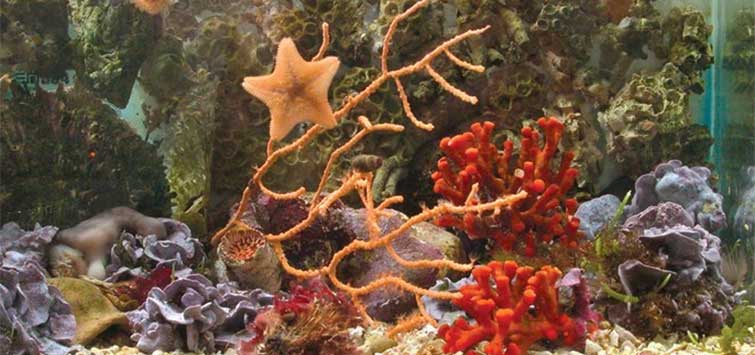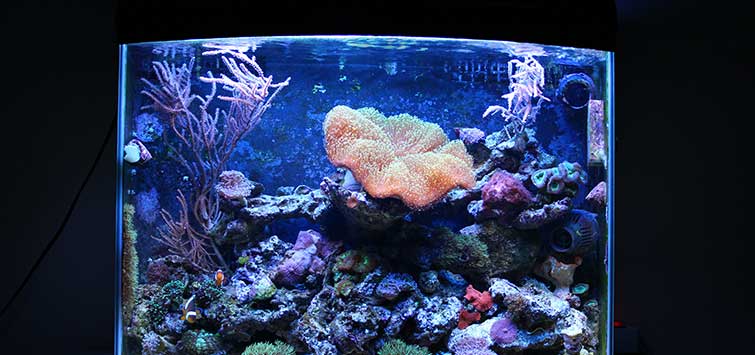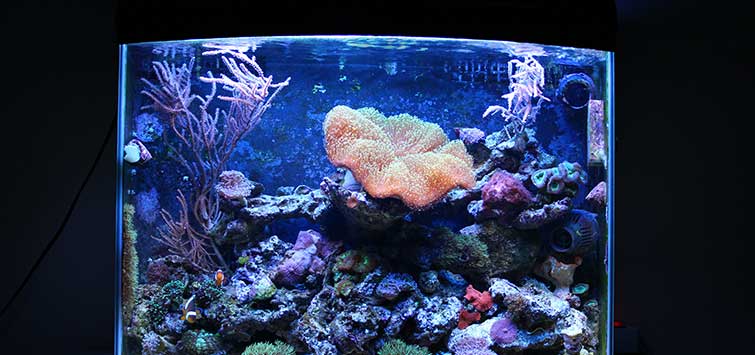A Mediterranean Nano
Author: Valerio Zupo
The Mediterranean is a vast wonder with enormous biodiversity, but one innovative Italian aquarist keeps a relatively tiny setup showcasing some of its more miniscule life forms.
A Variety of Tanks
Thirty years ago, despite aquarium keeping being a booming discipline, most aquarium shops stocked only fairly small tanks. Over time, as larger tanks allowed for the keeping of many more types of fish, small aquariums were pretty much relegated to the world of toys, and respect was only given to tanks 30 gallons and up. I wonder, however, if establishing the minimum size for an environment whose purpose is to host not-yet-defined guests makes any sense.
A 2½-gallon aquarium is large for a couple of Mediterranean shrimp Hippolyte inermis, and it allows for a continuous expansion of a small community as the shrimp reproduce. On the other hand, a 250-gallon is definitely insufficient for a loggerhead sea turtle Caretta caretta, even when still young. A pair of Amphiprion percula can live and spawn in a 10-gallon tank with just a flowerpot home, but they would probably appear disoriented and remain entrenched in a corner or in their flowerpot if moved to an otherwise-bare 150-gallon aquarium.
The minimum size of an aquarium should therefore be proportional to the number, size, biology, and behavior of the organisms it will host. It is in no way an absolute concept.
Nano Tanks
There is a modern trend back to small aquariums. There are problems associated with them, as they must be properly set up and maintained. An advantage of these small systems, on the other hand, is to be very manageable—partial water changes become a breeze, and the set-up and operating costs are low.
Tank Size
What is the minimum volume to achieve a magnificent Mediterranean marine aquarium? Most readers would be tempted to answer 25, 50, maybe 80 gallons. A larger tank, obviously, will easily provide excellent results. In fact, a big volume of water dilutes errors and preserves stable ecological conditions when a small tank might crash. However, modern compact accessories offer incredible performance and make keeping nano tanks much easier.
Today, a good specialized shop may offer miniature internal filters, mini air pumps, and everything needed to set up a Mediterranean nano aquarium. There are many innovative and intriguing possibilities, one of which is assembling a complete Mediterranean marine aquarium, fully functional and incredibly pretty, in just 2 gallons of water. Some readers might object to such a concept. Can such a small aquarium be stable, or will it only be some kind of holding cage for fish and invertebrates? The answer is, yes, it can be stable!
Choosing Specimens
Through modern technology, we can provide a stable environment perfectly fitted to the life of the livestock, one that is elegant and suitable for any room.
But of course, even a regular large aquarium window on the Mediterranean can present only some of its life forms—you cannot keep dolphins and swordfish in a home aquarium. In the same way, a regular setup cannot highlight the beauty of the smallest organisms, which are simply lost from view. Anyone who has snorkled in only a few inches of water along a shore has noticed the magnificent beauty of many small animals that can only be seen with your nose up against the rocks.
Think about the emerald green of the Posidonia shrimp, the sly appearance of small blennies, the elegance of the tiny prairie star Asterina gibbosa, and the complex ethology of small decapods such as Cestopagurus timidus, Munida spp., and galatheids.
Even a very common gorgonian will present itself differently depending on whether it is simply observed from a distance (as in a standard-size aquarium) or at closer range. Up close, one could witness tiny polyps with their slender tentacles searching for microscopic prey. In a standard-size aquarium, this may completely disappear behind a slow-swimming grouper. A micro-aquarium will naturally only contain organisms perfectly fitted to the tank, but there are several thousand species that can adapt well to your new marine mini-tank.
Setting Up a Crystal Tank
The first step is to build (or purchase) a beautiful crystal tank. Given the wanted size and aesthetics, only first-rate materials should be used. The tank can be constructed with excellent glass plates that are relatively thick (4 to 5 mm), though a superb alternative could be an all-crystal tank arranged on a glass support.
I decided to place my tank on the marble surface of the bathroom sink to start the colonization process, as it was the only room not invaded by aquariums in my apartment. I used, in particular, a 20 x 27 x 17 cm (8 x 10 x 7 inch) glass tank covered with a lid made from a simple, single piece of glass shaped with two small lateral openings to permit the passage of pipes.
Given the small size of the tank, I needed a simple solution that would allow me to avoid cluttering the look with pipes and accessories but functional enough to guarantee ecological stability. I decided that a single pump had to drive the entire system; I found it unimaginable to fill the limited space with more than one. The tank required an efficient and invisible filter, as well as a cooler, both of which would be essential to ensure ideal living conditions for the fauna and flora of the Mediterranean environment. I decided to avoid the use of any lighting system, as daylight would be sufficient to meet the needs of shade-loving organisms.
Decoration was also a key focus of the job. It was necessary to develop a homogeneous environment that would have a natural appearance, one that would not rely simply on rocks and stones to fill empty space. Ad hoc technological solutions were identified.
Filter
The filter not only had to be efficient, it couldn’t suck in larvae and other small organisms. Designed from scratch, it would be a hybrid system composed of a gravel filter and a sponge filter.
The Mechanical Filter Chamber
I used two small pieces of 4-mm glass measuring 16.5 x 5.5 cm (6½ x 2 1/6 inches). These were glued at the two sides of the left back corner, 5½ cm away, and then rested on a 4-mm spacer (a rubber stopper or something similar located on the bottom) so they would form a rectangular chamber communicating through the bottom (4-mm space) with the main tank.
The Gravel Filter
I cut a piece of garden netting to a size that matched the bottom of the tank (20 x 27 cm [8 x 11 inches]). A cross cut about 5 cm (2 inches) long (along the diagonal of the rectangle) was made in the left rear of the net, and the triangular edges were then folded in order to adapt them to the space occupied by the filter. Of course, such a small tank cannot host a conventional gravel filter; it would be too high and occupy an enormous volume. I therefore used rubber stoppers as a support for the garden netting. I cut the inside circle of the stoppers in order to get 4-mm thick rings, which I then glued under the netting with silicone sealant.
After waiting 24 hours for the sealant to cure, the net was placed on the bottom of the tank so the two flaps could be attached to the vertical walls of the filter. Finally, I covered this grid with about 3 kg (6½ pounds) of coarse gravel consisting of tiny shells and other calcareous materials. The weight of the sand keeps the net in position and makes it adhere to the walls of the filter, and its surface will provide an efficient biological filter as it is colonized by aerobic bacteria.
The Mini Filter
After the gravel filter came the mechanical chemical sponge filter. On the bottom of the glass chamber in the left back corner, I placed a 3-cm (1 1/5-inch) sponge cut to fit. I placed a commercial mini filter loaded with synthetic sponge and activated carbon on top of this.
The Complete System
The water circulation system is quite simple. Water passes vertically toward the bottom, through the gravel (thus limiting turbulence and preventing the intake of small organisms), reaches the undergravel chamber, then moves toward the back left corner and into the mechanical filter. There it flows vertically up through the sponge and the charcoal, and then reaches the centrifugal pump. From there it is pumped into the chiller, from which it flows under pressure into a perforated pipe to be sprayed evenly 45 degrees toward the back to avoid excessive turbulence and create a useful circular current. For these purposes, two plastic green tubes 1 cm (2/5 inches) in diameter were bent by filling them with sand and heating them.
You might think this filter is backward, with the mechanical filter following the biofilter (the gravel), but it works. The reason is that the suction flow is very slow through the gravel bed, distributed over the entire surface, and it does not clog with detritus. The large grain size does not trap most detritus, which passes through and reaches the mechanical filter. The latter, finally, makes the water clear (charcoal) and detritus-free (sponges). The sponges are easily cleaned every week to extract most organic detritus.
The Chiller
The chiller chosen is very small (several models are available in pet shops) and uses an electronic system to produce cold water. It is thus silent and more than sufficient for the small tank. It also contains an electronic thermostat, which was set on 18°C (64°F).
Decorations
I collected dead corals and other such materials to dress up the tank. Each item was cut in half using a metal hacksaw, which was an easy endeavor due to the crumbly nature of the calcareous materials. The halves were then glued to the back wall and the vertical surfaces of the filter with small drops of silicone sealant. Finally, the spaces between individual stones and corals were filled with silicone sealant and splattered with sand. This way, a natural three-dimensional background was obtained without taking up too much space.
The tank looks great from any direction even when empty. After letting the sealant cure for 24 hours, I filled the tank with artificial seawater and powered up the two electric components (pump and chiller). I could finally enjoy the aquarium in operation—it was beautiful!
Livestock
I added a bacterial activator to accelerate the maturation of filters. The environment created was perfect according to all the chemical and physical parameters after the first week: pH 8.4, temperature stable at 18°C (65°F), and no nitrogenous compounds. Here are the specimens I chose:
• Yellow gorgonian Eunicella cavolini
• Nudibranch Berthella aurantiaca
• Four snails Nassarius incrassatus
• 15 shrimps Hippolyte inermis
• Monaco shrimp Lysmata seticaudata
• Dwarf lobster Munida sarsi
• Porcelain crab Pisidia longicornis
• Mediterranean bivalve Pinna nobilis
• Two small fishes Opeatogenys gracilis
• Four Cestopagurus timidus
• Five Aiptasia anemones
• Ghost shrimp Pontonia sp.
• A couple of clams
• Two sea stars Asterina gibbosa
• Red Mediterranean feather star Antedon mediterranea
• Various red algae
• One small Codium bursa
• A pair of erect bryozoans
This is quite a number for the limited space available! However, the small size of the organisms chosen made it possible, as demonstrated by the continued chemical and physical stability and the good health of all the inhabitants. In fact, several other species of small fish could be kept and bred in this small tank, such as the blunt-snouted clingfish Gouania willdenowi, small-headed clingfish Apletodon dentatus, two-spotted clingfish Diplecogaster bimaculata, shore clingfish Lepadogaster lepadogaster, Connemara clingfish L. candollei, and painted goby Pomatoschistus pictus.
Over the Long Haul
The gorgonian, upon introduction, showed glaring signs of damage. It had been captured by fishermen using bottom trawls, and its coenosarcs (the common body of a coral colony) were damaged in several places. This was indicated in areas where the skeleton appeared naked. I had tried several times to rescue individuals in this state in the past in larger tanks, and generally I had to witness the gradual decay and death of the entire colony.
This colony has been shown to be at ease in the micro-aquarium, however, continually crossed by a horizontal current resulting from the spray bar. After five days the degeneration ended, and the polyps started building new tissues. Within 15 days the entire colony had been repaired. It is almost always open and in excellent condition.
Berthella aurantiaca
The nudibranch Berthella aurantiaca loves to move under the water surface, probably to remove the bacterial film and food particles. This animal is sensitive and delicate in an aquarium. One month after introduction, it produced a showy egg mass close to the spray bar! Unfortunately, the eggs were rapidly consumed by other inhabitants.
Nassarius incrassatus
The snails Nassarius incrassatus are the most interesting inhabitants. They spend most of the day buried with their siphons out of the gravel. Once any food is introduced, they quickly emerge and go back and forth through the aquarium in search of their prey. These mollusks are the first to perceive the smell of food thanks to a sophisticated system of chemical sensors.
In this small aquarium they can be observed very closely—note the small eyes at the base of the tentacles, the shape of the siphon, and the funny foot with two expansions. These mollusks laid eggs, and I was able to describe for the first time their larval development.
Hippolyte inermis
The shrimps Hippolyte inermis were also of great interest. They had a beautiful emerald-green color at the time of capture, but after a few days in the aquarium they faded and took on the main colors of the environment. It’s interesting to note that their bodies have developed reddish patches that mimic the color pattern of the gravel.
Lysmata Shrimp
The Lysmata shrimp is strong and agile, but quite cryptic. It found a home in a gap between a rock and the filter, and remained inside most of the day. Only in the evening can I enjoy its elegant presence and longitudinal red stripes.
Munida, Pisidia, and Cestopagurus
Munida and Pisidia, as well as Cestopagurus, are truly micro guests. You must get close to the front glass and examine individual grains of sand in order to see them, but it’s worth the effort—these little guys are active for most of the day and provide wonderful performances.
Opeatogenys
Opeatogenys are simply incredible! After an initial period of life on the front wall, they relocated to the back of the tank. At first I thought they had gone to a better life, but now they fight for territory back there and occasionally prey on a small Hippolyte. It was a hilarious sight to observe one of those tiny fish stuck to the glass with the head of a shrimp protruding from his mouth, though of course I was sad for my shrimp! On the other hand, they have a playful and intriguing character. I often see them among the rocks, and they appear amazed to see my strange face when I try taking close-up photos.
Asterina
The same could be said of Asterina, which spend most of the day on the glass walls and usually in the upper parts of the tank. They would be almost invisible in a larger aquarium. Antedon had been collected carelessly by a friend and had lost some arms, but it settled in immediately and regrew what was missing, although they remained small compared to the old ones.
Algae and Bryozoans
Similarly, the algae and bryozoans adapted to the new environment perfectly and, having fixed to the substrate, started a slow expansion. Codium bursa lived in this tank for several years in the absence of artificial light, doubled its size, and died only after a problem with temperature regulation. Overall, the aquarium works well. The water parameters are still perfectly suited to the life of all the organisms.
Water Changes
The first substantial water change (50 percent) was made after a few months of operation because the water appeared slightly amber. Of course, in a 2-gallon tank even a total change can be done with little effort! The structure of the tank makes the replacement of water fairly easy. I simply introduce a tube to the bottom of the filter after removing the pipes and the filter to remove water, and at the same time I add water to the opposite corner of the tank through a second tube connected to a storage container. In this way, the water is slowly replaced without disturbing the inhabitants.
This experiment shows that a Mediterranean aquarium can be created using tanks of any size—it is just necessary to adjust the size of the inhabitant! The accessories have proven to be perfectly suited to the small tank, even though they were designed for larger aquariums. The technologies applied are easily transferable to aquariums of any size. And such a small tank is suitable to be placed in any home environment, from a desk in the living room to a shelf in the bathroom, captivating the attention of all observers, like any well-designed aquarium should.
See the full article on TFH Digital http://www.tfhdigital.com/tfh/201102#pg95




